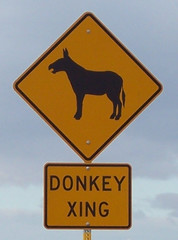One of Mali's treasures is a 150km long rock escarpment called the Falaise de Bandiagara, located between Timbuktu and the Burkina Faso border. Although the escarpment is an impressive sight in itself, it is the villages on, below and in the escarpment that make the place magical. The Dogon have populated the escarpment since the 14th century, displacing the Tellem people. Nowadays the Dogon live a simple life that has barely changed over the centuries, grounded in their ancient culture and animist religion.
Benigmato, the first Dogon village we visited, is a tranquil community surrounded by awesome cliffs. There are separate Muslim, Catholic and Animist areas within the village, although there is considerable overlap in beliefs and practices between the three. Ancient animist rituals are observed and polygamy is practiced throughout the village.
We were shown around the Catholic church by Daniel, whose father was the first Catholic in the village.
Hunting is one of the few activities Dogon men engage in, leaving farming, trips to market and domestic work to the women. This home is a typical Dogon hunter's home, decorated with souvenirs from successful hunts including the skulls and skins of monkeys, cats and snakes.
The village of Yaba-Talu with its breathtaking backdrop.

Ali guides our horse and cart past this baobab tree.


Nearly at the top of the escarpment are dwellings left from the Tellem people. The Dogon believe the Tellem were able to fly in order to reach their extremely high abodes. Our guide said they most likely climbed vines and trees that covered the previously forested area hundreds of years ago.

Lepe and Jason pause for a moment after climbing halfway up the escarpment.

This woman was more than happy to pose for a photo after we gifted her a couple kola nuts. The mildly hallucinogenic, and surprisingly expensive, kola nut is the preferred gift to members of the Dogon community.

Here we are pausing for a quick moment as we scrambled up and down the escarpment above the village of Teli.

Typical remnants of Dogon houses strategically placed halfway up the escarpment.

This Dogon mosque in the village of Kani-Kombolé is an eye catching example of Sudanese style architecture typical in this part of West Africa. The mud construction is supported by wooden beams, which are also used to access various parts of the exterior in order to make repairs after the rainy season.

We came across these boys on our first day in Dogon Country. They were making music with traditional percussion instruments at a crossroads. Apparently this is a required activity for boys who are preparing for their imminent circumcision. We were invited to attend a circumcision ceremony in a Dogon village on Rachel's birthday, although we opted for a cool swimming pool and mini-golf, rather than the snip and slice festivities. We may have passed up a once in a lifetime opportunity there.

Garamond, the proprietor of the roof we slept on our first night in Yaba-Talu, proudly poses next to one of his houses. He was a very kind man and keen to show us the honey-making expertise of the local bees. When he learned we lived in the USA, his first comment was "George Bush. Crazy man."

Garamond takes a few moments to relax in the shade with two of his mates. The man in the middle is Ali, who managed the horse and cart which carried our gear during the three day expedition.

One of the most impressive aspects of the Dogon Villages was the wood carving. The Dogon doors and ladders were unique in design and of high quality craftsmanship.







0 Comments:
Post a Comment
<< Home